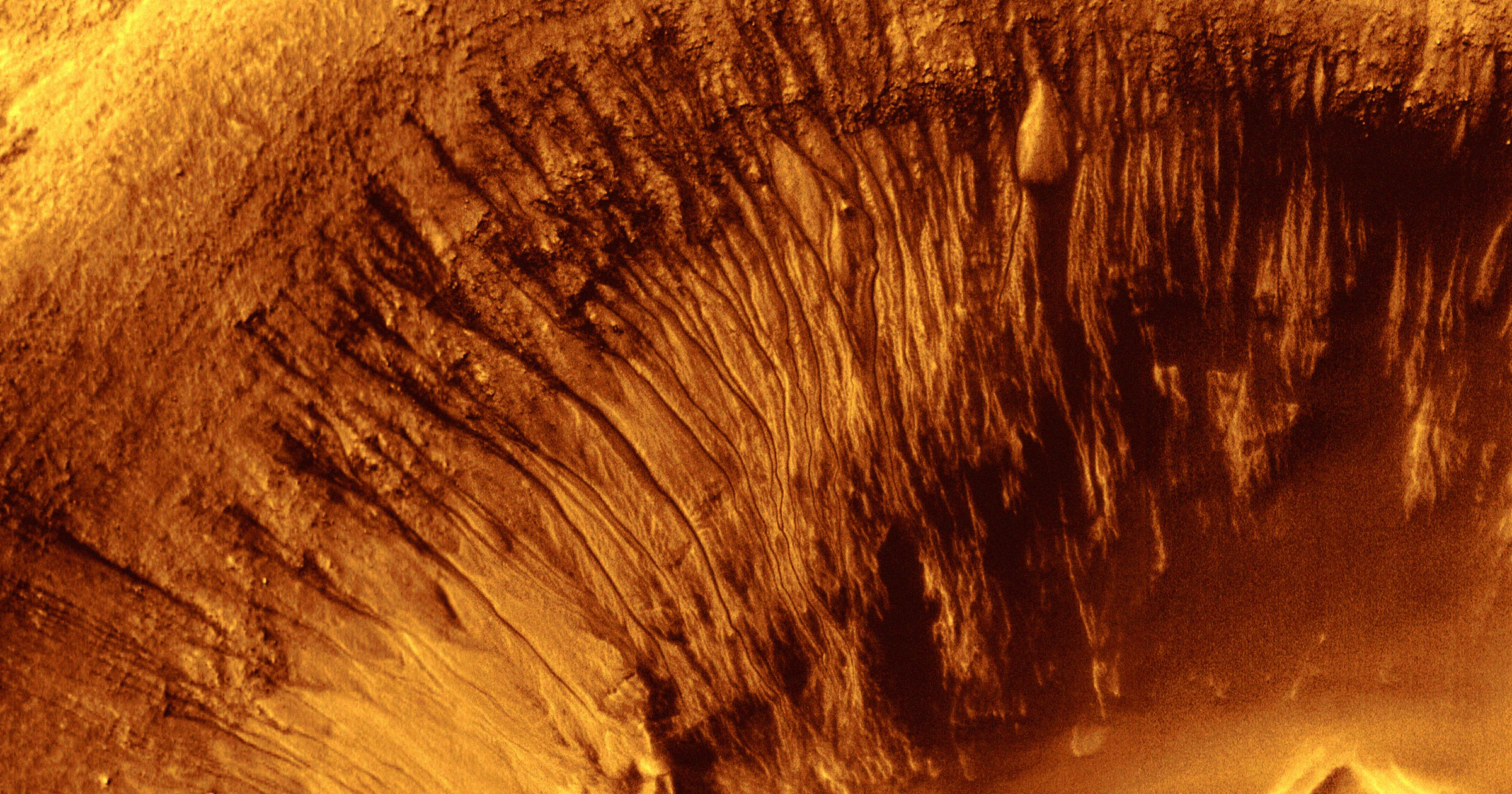Science
Scientists Uncover Mars’ “Burrowing” Mystery with New Research

Researchers at Utrecht University are exploring the enigmatic formation of gullies on the Martian surface, suggesting they result from unique “burrowing” actions of carbon dioxide (CO2) ice. This theory, which challenges previous beliefs regarding liquid water shaping the Red Planet’s landscape, is detailed in a recent publication in the journal Geophysical Research Letters.
For decades, scientists have contemplated how narrow channels, known as gullies, formed on Martian dunes. Initial hypotheses indicated that these features emerged from flowing water billions of years ago. Yet, observations from NASA’s Mars Reconnaissance Orbiter shifted the focus to seasonal freezing of CO2 as the primary cause.
Lonneke Roelofs, an Earth scientist at Utrecht University, conducted laboratory experiments to simulate Martian conditions. Her goal was to observe how blocks of CO2 ice interact with the Martian pseudo-regolith. “It felt like I was watching the sandworms in the film ‘Dune,’” she remarked, highlighting the fascinating nature of the research.
The study reveals that for CO2 ice blocks to form on Martian dunes, temperatures must plummet to an extreme -184 degrees Fahrenheit during the winter months. As temperatures rise towards the end of winter, these ice blocks, which can reach lengths of up to three feet, may break off and initiate the burrowing phenomenon. The stark temperature differences between the warming dunes and the cold ice blocks can cause gas to sublimate from beneath them, leading to explosive behavior that displaces sand.
Roelofs and her team utilized the Open University’s “Mars chamber,” a facility designed to replicate the harsh Martian environment. “In our simulation, I saw how this high gas pressure blasts away the sand around the block in all directions,” she explained. This process allows the ice block to dig into the dune, gradually sliding down and forming a gully.
Through various experiments, the researchers adjusted the angles of the dune slopes. When a block of CO2 ice was released from the top of a slope, it began to burrow into the material below, mimicking the action of a mole. “It looked very strange,” Roelofs added, emphasizing the unusual outcomes of their simulations.
As temperatures rise in early spring, the remnants of this burrowing process leave behind only a small hollow in the sand. “Once the blocks reach the bottom of the slope and stop moving, the ice continues to sublimate until all the CO2 has evaporated,” Roelofs noted. The result is a distinct landscape feature that provides insights into the planet’s geological history.
Beyond the quest to uncover evidence of past life on Mars, Roelofs believes that studying other planetary landscapes can yield valuable insights for Earth. By examining the formation of features on Mars, scientists can challenge existing frameworks and pose new questions that may enhance our understanding of Earth’s geological processes.
The research sheds light on both the historical conditions of Mars and the potential for new discoveries that could reshape our understanding of planetary science. As scientists continue to investigate the mysteries of the Red Planet, findings like these contribute to a broader understanding of the universe and our place within it.
-

 Science2 months ago
Science2 months agoInventor Achieves Breakthrough with 2 Billion FPS Laser Video
-

 Health2 months ago
Health2 months agoCommunity Unites for 7th Annual Into the Light Walk for Mental Health
-

 Top Stories2 months ago
Top Stories2 months agoCharlie Sheen’s New Romance: ‘Glowing’ with Younger Partner
-

 Entertainment2 months ago
Entertainment2 months agoDua Lipa Aces GCSE Spanish, Sparks Super Bowl Buzz with Fans
-

 Health2 months ago
Health2 months agoCurium Group, PeptiDream, and PDRadiopharma Launch Key Cancer Trial
-

 Top Stories2 months ago
Top Stories2 months agoFormer Mozilla CMO Launches AI-Driven Cannabis Cocktail Brand Fast
-

 Entertainment2 months ago
Entertainment2 months agoMother Fights to Reunite with Children After Kidnapping in New Drama
-

 World2 months ago
World2 months agoIsrael Reopens Rafah Crossing After Hostage Remains Returned
-

 Business2 months ago
Business2 months agoTyler Technologies Set to Reveal Q3 Earnings on October 22
-

 World2 months ago
World2 months agoR&B Icon D’Angelo Dies at 51, Leaving Lasting Legacy
-

 Health2 months ago
Health2 months agoNorth Carolina’s Biotech Boom: Billions in New Investments
-

 Entertainment2 months ago
Entertainment2 months agoRed Sox’s Bregman to Become Free Agent; Tigers Commit to Skubal









